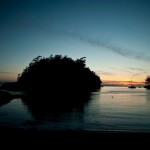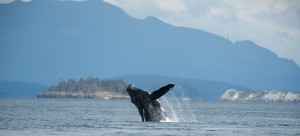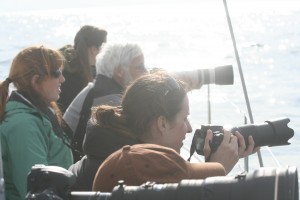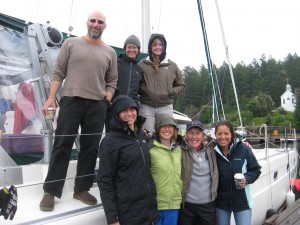The Chase
I’m sure you all are wondering if we’ve seen any whales these past few weeks. At this point I’m thrilled to say we have seen them more than a few times! Initially, it seemed that the whales were avoiding us or at least choosing the exact opposite direction and side of the San Juan Islands in relation to wherever we were. Days past with this sense of disappointment but determination kept us going. Our lingering hope led us to venture far into northern and southern parts of the Salish Sea. One day, we travelled up to my favorite island so far; Patos Island, in hopes the reported killer whale’s up in Pt. Roberts, Canada would continue on one of their annual routes down south between Patos Island and Eagle Point.  After taking night shifts listening to underwater hydrophones that are located throughout the islands we woke up the next morning knowing that they whales hadn’t passed our location. The day ended with news the whales were transients and going at a slower pace then expected. We were unable to see any whales that day, but our efforts continued nonetheless.
After taking night shifts listening to underwater hydrophones that are located throughout the islands we woke up the next morning knowing that they whales hadn’t passed our location. The day ended with news the whales were transients and going at a slower pace then expected. We were unable to see any whales that day, but our efforts continued nonetheless.
Another day we travelled an even farther distance south around Whidbey Island. Supposedly we were the first Beam Reach course to go this far south! We had heard that J pod was seen down in that area so we spent the day looking and found gray whales and a breaching Minke instead! This is very rare to see a Minke breach so our long trip down ended up being worth the time and fuel used.
I feel like I haven’t explained how exactly we go about finding the whales. I make it sound  as if we use underwater hydrophones as our main locating source, but this only half of our method! One part is to check to see if killer whale call spectrograms were picked up from the Lime Kiln underwater hydrophone if necessary, or listen to the hydrophones that stream live on orca sound at http://www.orcasound.net/ to see if we can locate the direction the whales are travelling. Our other main locating source is communicating with people. We keep in contact with land based observers, Vancouver, Victoria and San Juan Island whale watching boats, along with other companies such as the Whale Museum, the Whale Research Center, Sound Watch and Strait Watch. Each contacts purpose is either to educate boaters on vessel noise and how it can negatively impact whale communication, educate and entertain the public about their general biology or to continue research on the Southern Resident killer whale’s.  All of these contacts serve as vital source for our knowledge of the southern resident and transient killer whale location. In order for us to create an equal sharing of information relationship with these contacts we try and relay any information of what marine mammals we see on our daily routes. There are exceptions when there is the concern of overcrowding the whales, so we make it a point to be very careful about who we relay the information to.
For the past 4 weeks the information we have been able to provide for others is actually not about finding the Southern Resident killer whales.  When pulling out of Snug Harbor along the west side of San Juan Island on May 8th. Ally  spotted a humpback whale! Not only did we see a humpack whale but we caught them in a playful state allowing us to see the giant mammal breach multiple times! The amazing photo below was taken by our photographer/video-augrapher Carlos Sanchez.
There was also pectoral and chin slapping that occurred. After our initial shock of observing a humpback breach not too far from our catamaran we called all of our contacts so that they could share in the enjoyment. That was the first moment we felt so good about giving information to our contacts instead of only receiving what they had to tell us.
We have also seen the Southern Resident killer whales for 5 days total so far,  and it was all possible because of this connection with other whale observers and researchers!
and it was all possible because of this connection with other whale observers and researchers!






 Twitter
Twitter LinkedIn
LinkedIn Facebook
Facebook